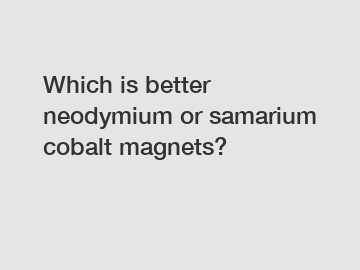Which is better neodymium or samarium cobalt magnets?
Which is better neodymium or samarium cobalt magnets?
Neodymium and samarium cobalt magnets are two popular types of permanent magnets used in various industries. Both these magnets possess unique characteristics and are often compared to determine which one is better. In this article, we will delve into the properties and applications of neodymium and samarium cobalt magnets to shed light on which one may be the superior choice.
1. Magnetic Strength:

One of the most crucial factors to consider when comparing magnets is their magnetic strength. Neodymium magnets are known for their exceptional magnetic power. They have the highest magnetic strength of any commercial magnet and can generate impressive magnetic fields. On the other hand, samarium cobalt magnets also exhibit strong magnetic forces but are slightly less powerful than neodymium magnets.
2. Temperature Resistance:
Another essential aspect to consider is the magnets' ability to withstand high temperatures. Neodymium magnets have a limited temperature resistance, usually up to 80°C (176°F). Beyond this temperature, their magnetic strength begins to decrease. On the contrary, samarium cobalt magnets have far better temperature stability and can tolerate temperatures of up to 350°C (662°F) without significant loss of magnetic properties. This makes samarium cobalt magnets the preferred choice when dealing with high-temperature applications.
3. Corrosion Resistance:
The resistance of magnets to corrosion is essential, especially when they are used in moist or outdoor environments. Neodymium magnets are vulnerable to corrosion due to their iron content. They require protective coatings, such as nickel plating, to prevent deterioration. Samarium cobalt magnets, on the other hand, have excellent corrosion resistance and do not require additional coatings. This makes them suitable for applications where exposure to moisture or humid conditions is likely.
4. Cost Considerations:
Cost is often a significant factor when determining which magnet to use. Neodymium magnets are relatively more affordable compared to samarium cobalt magnets, primarily due to the availability of raw materials. However, it is crucial to consider the specific requirements of the application and the advantages offered by each magnet type before making a decision solely based on cost.
In conclusion, the choice between neodymium and samarium cobalt magnets boils down to the specific application's requirements. If high magnetic strength is crucial and operating temperatures remain within limits, neodymium magnets are an excellent choice. Alternatively, if the application involves high temperatures or exposure to corrosive environments, samarium cobalt magnets outshine neodymium magnets due to their superior properties. Budget considerations should also be taken into account when making the final decision.
Regardless of the magnet chosen, both neodymium and samarium cobalt magnets have revolutionized various industries, including electronics, automotive, aerospace, and renewable energy. They play a crucial role in providing efficient and compact solutions for emerging technological advancements.
In conclusion, there is no definitive answer to which magnet is better as they both possess unique properties suited for different applications. Ultimately, it is essential to prioritize the specific requirements of the application and consider factors such as magnetic strength, temperature resistance, corrosion resistance, and cost before making a final decision.
For more information, please visit Magnetic Steel Triangle Chamfer, Insulation Laminated Magnet, Formworks Button Magnet.

Comments
0